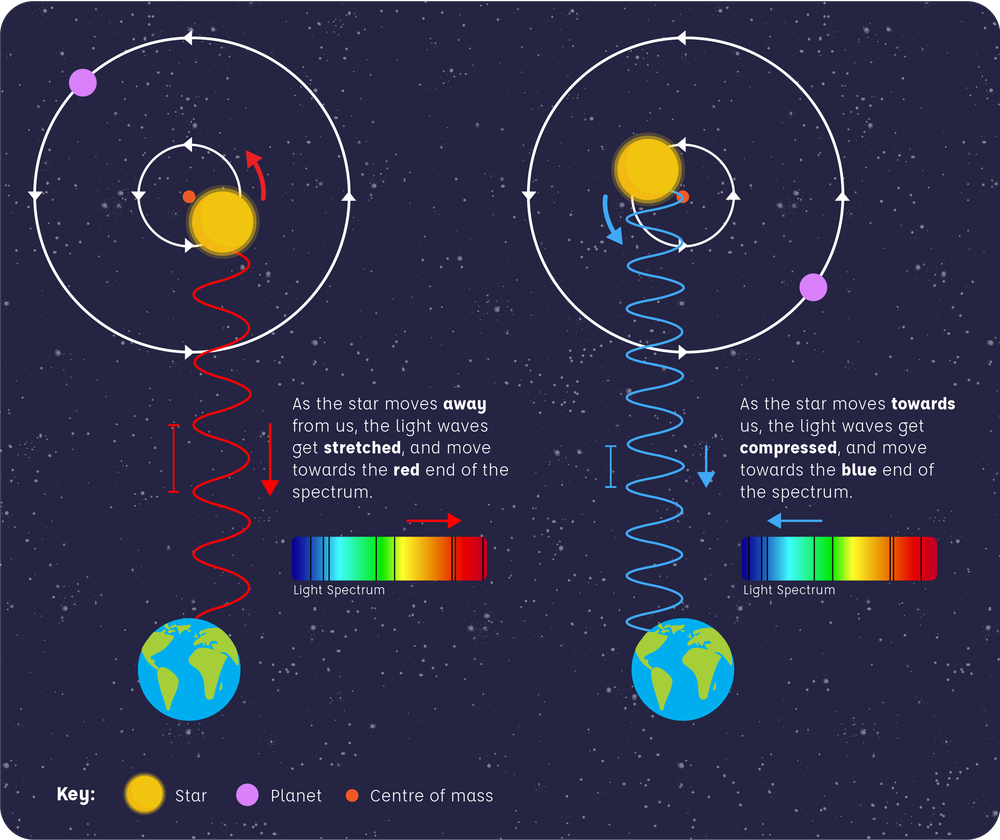Is there life out there? Is there a planet that has the right conditions for hosting life? These are some of the most pressing questions in astronomy today. To answer them, astronomers need to first detect planets orbiting stars other than our Sun.
Easier said than done. The nearest star – Proxima Centauri – is 4.25 light years away. That’s 40 trillion kilometers. Additionally, a star is a bright luminous object. A planet is not. Our Sun is approximately a billion times brighter than Jupiter – the largest planet in our Solar System.
In other words, the task is akin to detecting a fly orbiting a bright lamp in an airplane from the surface of the Earth.
However, scientists have embraced this challenge. Using state-of-the-art telescopes and ingenious detection techniques, they have managed to detect and obtain details of more than 5000 exoplanets out there.
Let’s understand how it is done.
What makes a good host star?
The first step is to find a good host star.
A variety of stars abound in the universe – from big blue ones to small red ones. This variety can be grouped into different spectral classes – O, B, A, F, G, K, and M. The primary criterion of this classification is the surface temperature of the star.
An O-type star is the hottest (T ~ 30,000 Kelvin), while an M-type star is the coldest (T ~ 3,500 Kelvin). Our Sun, with a surface temperature of approximately 5,500 Kelvin, is a G-type star.
Source – Wikipedia
Another important physical parameter of a star is its luminosity – the amount of energy it’s emitting in all directions. Clearly, an O-type star will emit the most amount of energy and an M-type star the least.
If we now take a group of stars and plot their luminosities against their spectral types or surface temperatures, we get a plot called the Hertzsprung-Russell (HR) diagram.
One of the most prominent features is the long diagonal patch that starts from the top left (high luminosity and high temperature) to the bottom right (low luminosity and low temperature). This patch is called the Main Sequence.
 Source – Western Washington University
Source – Western Washington University
Stars in this region are fusing hydrogen into helium at their core and are stable. They spend 90% of their lives here. Once a star runs out of hydrogen at the core, it exits the main sequence.
Stars in the top left part are called Blue Giants, while those in the bottom right are called Red Dwarfs. This is because the more luminous and hotter a star is, the larger it will be, and vice versa.
However, a large star with high luminosity means that it is running through its fuel at a high rate. It will exit the main sequence sooner than a small star with low luminosity. On average, blue giants live for around 10 million years, while red dwarfs stars can live up to 100 billion years – that’s longer than the age of the universe!
Being a G-type star, our Sun is 5 billion years old. The oldest planet in the Solar System, Jupiter, is 4.6 billion years old. The Earth is 4.5 billion years old. According to the accretion model of planet formation, the young planetary embryos can take at least 100 million years to form.
Therefore, statistically speaking, the chances of planets forming around higher spectral type stars are extremely low.
Another important factor to consider here is the surface activity of the host star. Due to their high luminosities and temperatures, O to A-type stars emit strong X-ray and UV radiation. Even if a planet could form around such a star, such intense radiation could make the planet’s surface extremely inhospitable.
The stars that are most likely to host planets are, thus, the main sequence F,G,K stars.
How do we detect exoplanets?
Now that we know which stars to point our telescopes at, the next step is to figure out how to detect planets orbiting them. There are multiple detection methods. Here, the two techniques relevant to this article are discussed here.
Transit Method
One of the most widely used techniques is the transit method. Imagine yourself looking at a light bulb and noting its flux, or the amount of light you receive from it, with time. The plot of flux versus time is called the object’s light curve. If there is nothing between you and the bulb, this curve will be a straight horizontal line – the flux is constant with time.
Next, imagine that a fly comes between you and the bulb. This intervention will induce a dip in the light curve at that particular instant. If such dips are repeated and periodic, they would imply that the fly is flying repeatedly between you and the bulb. The simplest physical configuration to explain such an observation is that the fly is orbiting the bulb. The dips are periodic because it completes an orbit every time it intervenes.
This is the exact method by which the majority of exoplanets are detected. Astronomers search for significant periodic dips in a star’s light curve. A ‘significant’ dip is, however, equivalent to just a 1% reduction in the star’s flux. This is a testament to the engineering feats humans have achieved.

Source – NASA
The dip in the light curve is proportional to the size of the planet. Additionally, Kepler’s laws of planetary motion define a direct relationship between the time period with which the dips repeat and the distance at which the planet is orbiting the star.
Hence, the transit method of exoplanet detection reveals the planet’s size and orbital distance.
Since this method relies on the planet crossing our view of the host star frequently and dipping its light, it fails to find small planets, those that orbit far away from the star, and/or those whose orbital plane doesn’t intersect with our line-of-sight.
Radial Velocity Method
The Sun pulls the Earth. According to Newton’s third law of motion, the Earth equivalently pulls the Sun. The Earth orbits the Sun only because the latter is much more massive than the former. However, if the planet is big, it can induce tiny periodic motions in the host star. Jupiter, the largest planet in the Solar System, does so with the Sun.
Such miniscule periodic motions show up in the spectrum of the host star. When it is coming towards the observer, the various features in the spectrum will be blue-shifted; while it will be red-shifted when it is moving away. This is known as Doppler shifting. An everyday analog is the siren of an ambulance – the frequency of the sound increases as the vehicle approaches you and decreases as it goes away.
The heavier the planet is, the stronger the pull on the star will be. Hence, the doppler shift measurements give a good estimate of the planet’s mass.

Source – Las Cumbres Observatory
This method works only if the planet is massive and close enough to cause a significant difference in the host star’s position. Hence, it cannot detect small planets that orbit farther away.
What makes a planet habitable?
Now that we know how to detect an exoplanet and obtain its crucial physical parameters, we need to determine what combination of these parameters makes a planet habitable.
Orbital Distance
If the planet is too close to the host star, the surface temperature will be too high to sustain life. If it’s too far away, the temperature will be too cold. The sweet spot between these two extremes is called the star’s Goldilocks or Habitable Zone. The planet’s surface temperature here will be optimal for life. The Earth is in the Sun’s habitable zone, while Mars is near its outer edge.
Size
A small planet may not have enough gravity to prevent essential atmospheric molecules from escaping its pull. Conversely, a large size will make the planet almost completely gaseous. Mercury and Jupiter exemplify these two cases.
Atmosphere
An atmosphere helps regulate surface temperature through the greenhouse effect. Additionally, it shields the surface from harmful stellar radiation and maintains optimal surface pressure.
Magnetic Field
An absence of the magnetic field will allow streams of high-speed charged particles from the host star to strike the planet’s surface. They can strip the planet off its atmosphere as well. A good example in our Solar System is Mars. Thus, a planet without a magnetic field and atmosphere is not prime for life.
An important consequence of these parameters is the presence of a liquid unreactive solvent on the planet’s surface. This molecule needs to transport other important compounds from one point to another without any reactions. Such communication will allow life to sustain and spread itself around the planet. Water is a good example.
Of course, there are other important parameters too, such as the planet’s orbital inclination and the presence of moons. But the aforementioned ones form a good starting point for searching potentially habitable planets.
Potentially Habitable Exoplanets
Out of the 5000 confirmed exoplanets, quite a few of them have the potential to be habitable. A few such systems are:
- TRAPPIST-1 System: The TRAPPIST-I system consists of seven planets – TRAPPIST-1b, 1c, 1d, 1e, 1f, 1g and 1h – orbiting a red dwarf star. This family is located 40 light years away from us (1 light year = 9.46 trillion kilometers). The orbital distances of the planets range from 1.5 to 19 days. Their radii range between 77.5% and 113% of the Earth’s radius. This makes them optimal for habitability.
- Kepler-22b: Kepler-22b orbits within the habitable zone of a Sun-like star located about 640 light years away from us. The planet orbits its host star in a nearly circular orbit within 290 days. It is two times larger than the Earth, and could have a comfortable surface temperature of 22° C if it has an atmosphere.
- Kepler-186f: Kepler-186f orbits within the habitable zone of a red-dwarf star located about 580 light years away from us. It’s almost the same size as that of the Earth. Due to lack of mass estimates, it could be highly dense with a rocky surface, or have low density with a thick atmosphere. Without an atmosphere, its surface temperature could be around -85° C.
To Wrap It Up
In short, here’s how you would go about detecting a habitable exoplanet:
- Find a stable mildly active host star with a long lifetime.
- Find planets orbiting the star.
- Check whether any of them have properties that make them habitable.
It’s imperative to note a caveat with this entire prescription. The details provided here are modelled after the only star-planet system known to host life – the Sun-Earth system. Out of the trillions of planets present in a single galaxy, it’s not improbable for extremophilic creatures to survive in conditions that we currently assume are extremely hazardous. Life could appear in the thick atmospheres of a hot Jupiter orbiting near its host star. Alternatively, it could appear in the cold rocky surface of a Mercury-size planet orbiting far away from its star.
The options are endless.
As technology improves, we are bound to detect life outside Earth. Whether it will be carbon-based hydrophilic like us, or silicon-based hydrophobic like our computers, only time will tell.


